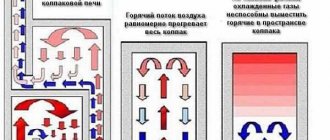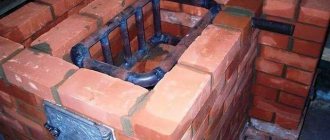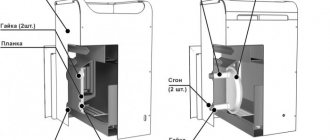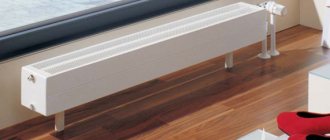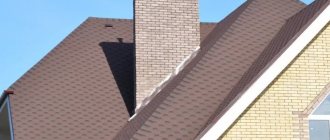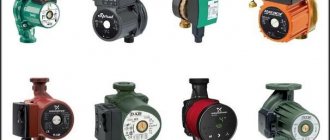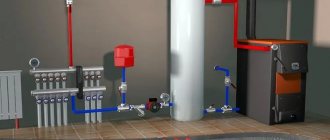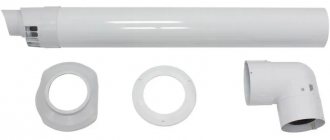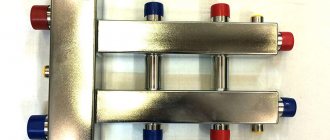Preparatory work
First of all, you need to choose a place to build a furnace.
The easiest way to do this is before building a house - then both the stove and the building are designed together so that three or at least two rooms are heated. With a ready-made house, the situation is more complicated. In this case, they tend to build the stove into an interior partition, since installing it into a load-bearing wall requires complex calculations and dangerous, time-consuming work (part of the wall will have to be dismantled, keeping the load from being blocked by a system of lintels and columns). You can, of course, limit yourself to a simple wall-mounted arrangement, but then only one room will be heated.
A reinforced concrete foundation must be built at the selected location. Its dimensions must exceed the dimensions of the oven by at least 100 mm on each side. It is not allowed to combine the foundation of the furnace with the foundation of the building - both structures give different settlements and one of the foundations will pull the other along with it, causing it to skew.
A reinforced concrete foundation must be installed under the furnace.
The depth of the foundation depends on the bearing capacity of the soil, the depth of its freezing, and the method of operation of the building (periodically/continuously). Typically, in buildings with year-round habitation of people located on stable ground, the foundation is deepened by 400–600 mm. Crushed stone should be poured onto the bottom of the excavation as a reinforcing layer, and a sand cushion should be placed on top of it.
Then everything is done using traditional technology - they install the formwork, fix the reinforcement frame and fill it with concrete. You should proceed to the construction of the furnace only after the concrete has fully matured and gained sufficient strength - this usually takes about a month.
How to prepare a place for the stove
To properly install such a stove, you need to carefully study the step-by-step installation instructions, features and recommendations. In general, this process consists of a preparatory stage, laying the first and second stages.
To properly install the stove, you will need some tools, including:
- Scoop and bayonet types of shovels.
- Reinforced metal rods.
- Formwork.
- Polyethylene film.
- Cement mortars.
- Sand material.
After preparing all the material and tools, you need to start preparing the place for the stove.
This process is carried out in several stages:
- Preparing a hole measuring one and a half meters by one meter, the depth should be eighty centimeters.
- Covering the bottom with sand material. The size of the layer of sand material should not exceed fifteen centimeters.
- After covering, the pit is left for two days to allow the sand materials to settle.
- Preparation of formwork, which is made from plywood or waste boards.
- Performing reinforcement using rods made of steel materials.
- Pouring cement mortar. It is necessary to distribute the solution evenly.
After all these activities, you need to leave it all for a certain period of time for the mortar and foundation to harden.
Basics
Most of the advantages of Kuznetsov furnaces come from the principle of free passage of gases. Let us explain again with an example.
Let's imagine a stove with a complex system of smoke ducts: an ethermark, a four-five-turn Dutch oven. In this cramped labyrinth, strong turbulence will inevitably arise. Have you heard the furnace humming? This is only a minor manifestation of the vortex energy raging within her. And there’s nowhere to get it from except from the fuel stash. If the channels are long and narrow enough, then at first glance there is nothing terrible here: the vortices, by the time they reach the pipe, will dissipate, cooling, and will still give their energy to the body of the furnace, and it to the room. But in reality, nuances appear, which will be discussed later in the text. Because of them, the efficiency of a channel furnace over 60% is an exceptional rarity.
In a channel stove, while it is being heated, a huge flow of energy rushes about, and only a small part of it can be used for heating or heating water without disturbing its operation. Such a furnace is somewhat similar to a nuclear reactor. Don’t be alarmed, just because of the synergy, i.e. along the paths of energy circulation in it. A nuclear reactor has to be loaded with tens of times more fuel than is necessary to ensure the design energy output. Otherwise, the neutrons will simply fly out without having time to meet the uranium atoms ready to receive them. In a channel furnace, hot vortices, without having time to cool, will fly out into the chimney or, conversely, will cool down immediately, producing smoke and soot.
But the Kuznetsovkas (details below) are closer in synergy to the thermonuclear reactors of the future. “Thermonylus” sounds scary, but this is only due to its association with the hydrogen bomb. In fact, fusion reactors are quite safe.
Why? Because they generate exactly as much energy as the consumer needs, and the technological power reserve required for rarefied plasma is scanty. If suddenly the chamber of a tokamak or stellarator suddenly completely collapses, the plasma will be completely emitted (there are no heavy atoms in it) and will cool down before it reaches the walls of the room. The repairmen will curse - maybe the duty department is sharpening their laces - but after 5 minutes. will be able to blunt to elimination without protective equipment.
So what do Kuznetsov furnaces have in common with thermonuclear reactors? The fact that the energy of the flue gases, thanks to the principle of free passage, does not rotate many times in the flow until it is pushed into the body of the furnace, but saturates it immediately. And now she has nowhere to go from there except into the room and/or the water heating register.
Operating principle
Such heating is effective for rooms with a total area of up to 60 m2, so the design of the stove itself is compact, does not require a high chimney and works according to the “automatic view” scheme.
Gases in such a chimney move according to the laws of natural convection, freely and not limited by the walls of the channels and valves. In this case, the unheated air flow simply flows around the hot air, rather than blowing it out of the oven.
The heat output of a given stove depends on the type of construction and the type of fuel used.
As an example, we can consider a stove with an outer wall of half a brick with a water-heating box, an oven and a cast-iron hob with two burners.
- To increase heat transfer, the firebox is covered with a cast iron plate. Heat transfer depends on the thickness of the slab, so it is advisable to take the slab as thick as possible. Above it is a cooking chamber in a niche with steel doors. The oven is located on the side of the firebox;
- The installation of a heating and cooking stove is carried out with the expectation of dual operating modes: summer and winter. When operating in summer mode, the stove is used as a stove. During operation, hot gas goes under the hob, oven, and then into the chimney;
- In winter operating mode, hot gas passes through the stove and oven, and then enters the upper chamber through the heating ducts, heating the room, and only then is removed into the chimney.
Formation of the second level
Continue laying in the usual way, the fence plate is fixed on one side with mortar. In the 19th row, it is necessary to install a brick in the center of the smoke collector, which will become a column under the roof of the stove. You need to leave a gap one brick wide behind the stove. They work on the same principle up to level 21.
Don't forget about the hood
Now they block the channel that leads to the pipe, the smoke will come out of the sinus, which was left in the lower part. In the next row, a steel plate is installed on the front walls of the oven. You can also use the factory rim with a door for this, which will greatly simplify the further construction of the steam collector.
At this stage they make a hood; ¼ brick will be enough. They continue laying up to the 24th row, and already on it it is necessary to lay out a step and attach the steam collector to the chimney, and make the channel closed. In the 27th, a fence plate is installed, and in the 28th, the structure is covered with a brick roof. At the next level, a pipe with a diameter of one brick is attached. The bell furnace is ready.
Operating principle
Kuznetsov proposed a new principle for constructing brick kilns. In all previously invented/designed models, hot gases move through channels. Passing through them, they heat the brick and cool themselves. Movement is possible only if there is traction. With this forced operating principle, the heating of the housing is uneven, which leads to the formation of cracks. A large number of bricks occupy almost the entire space, and there is nowhere to put a heat exchanger if necessary. Just place it in the firebox, where it will come into contact with the flame, which is why its service life is very limited. In addition, the heat exchanger located in the combustion zone takes away a significant part of the thermal energy, worsening the fuel combustion conditions, which reduces the efficiency of the furnace and increases the amount of soot.
One of the channel ovens looks like this inside
Kuznetsov uses a different principle of gas movement in the furnace - free. The oven consists of caps - vessels turned upside down (with or without a hole at the top - different in different models). The caps can be located above each other or one after the other, but they must communicate with each other using a dry seam - a space of 2-3 cm, unfilled with a solution or heat insulator, through which gases pass from one cap to another.
The first hood and firebox are combined into a single space. With such a device, this is what happens. The hottest gases rise to the top. For some time they remain at the top, where they transfer part of the thermal energy to the walls and cool down themselves. As they cool, they sink down, and hotter ones rise to take their place. With this construction, the movement of air masses occurs only due to natural physical processes.
The principle of gas movement in bell furnaces
You can clearly demonstrate the process by blowing a stream of smoke into a glass turned upside down. It rises up, reaches the top, then the cooled part of the smoke along the walls falls down. Noticeably the same processes, only much more complex, take place in the oven.
In the figure, red arrows show a diagram of the movement of hot air in bell-type furnaces. Blue arrows show the movement of cold air entering the oven. Obviously, it will not rise up, because it weighs more, but will go down and have almost no effect on the overall temperature in the bell, as shown in the figure on the right.
But one hood is not enough for effective heat extraction, which is why most furnaces have two or three domes, depending on the power. Almost the same processes occur in them as in the first one: hotter gases are at the top, heating the masonry, cold gases pass below and exit into the chimney. A heat exchanger or any other device necessary for any purpose is located in the upper zone of the second vault. No open fire, only hot gases and very efficient heat removal: high-temperature air currents constantly flow. Moreover, heating the coolant, stones or water in the tank does not have any effect on the combustion processes: they are separated from the firebox by a brick wall.
One of the bell furnace options
The design of stoves of different configurations and purposes is different, but they “consume” little fuel and remain hot for a long time. This is evidenced by the reviews of the owners. For example, in a house made of timber, such a stove is built. At -25°C, 5 logs of wood are heated in the morning and evening (in total, about 18 kg of firewood per day). It's +25°C in the house and it's not cold in the morning. At temperatures “overboard” down to -10°C, they are heated once. So there are no questions about efficiency. If there are any questions, it is about the choice of performer. After all, the parameters of its operation depend on how correctly and competently the stove is built. And you can’t make it quickly: medium-sized and without bells and whistles, it takes 2-3 weeks of work. In general, with reviews about Kuznetsov’s stoves, everything is simple: people are happy. The pleasure is certainly not cheap, but it is definitely worth it. This is confirmed by all owners of such stoves. There are no difficulties in operation, they are economical and not capricious, they give off heat for a very long time and heat up quickly.
Duct or bell-type?
Which is better: a time-tested average or a new promising upper limit? This dilemma has been going on for over 45 years among stove makers across the country!
How to choose between a pie in the sky and a bird in the hand, who can tell you which is better and how not to end up with nothing? If we turn the conversation to the topic of brick kilns, then all these questions can be reduced to one thing - which type of brick kiln is better, channel or bell-type? From all the variety of options for brick stoves, several varieties can be distinguished, differing from each other in their functionality; there are stoves only for heating, only for cooking, there are combined and highly specialized ones. However, according to their technical data, all of them are divided into two types of hot gas removal, and, accordingly, into their heating method. These two methods of removing gases have long been known to everyone - the channel system and the bell-type method. Debates about which method is better and which type of furnace gives the greatest return have been going on since the middle of the last century, because it was then that a model of a brick furnace was first created, in which the bell-type method of heating and removing combustion products was used.
In furnaces with a channel gas exhaust system, the main advantage is considered to be compliance with centuries-old traditions, quality proven by time and millions of users. The ease of manufacture and maintenance of these brick kilns is the best indicator. In stoves with a channel system, hot smoke is removed through a system of vertical or horizontal channels under the influence of natural draft; the greater the number of channels, the warmer the stove. However, the fact that the efficiency of any type of stove of a given configuration does not exceed 65% forces us to look for better options for heating rooms. But it is worth noting that, for example, the efficiency of Shvedok heating and cooking stoves, even if it is not a bell-type stove, is 25% higher due to the fact that the iron plate heats up quickly and releases heat into the room.
Furnaces with a dome heating system have completely different pros and cons. In furnaces of this type, hot gases move under the influence of two forces: one of which is the natural cooling of gases and their movement due to the difference in weight, the other is natural draft, but in much less quantity than in the furnaces of the first option. This is where a lot of controversy arises - under the influence of what does the gases move more, and, accordingly, due to what does more heating occur? Also, the fact that the dome system is more complex to manufacture and is practically impossible to clean after several years of service (there is no access to the top of the domes) does not allow us to take a leading position. The efficiency of this type of furnace, despite all the controversy, reaches 90%.
An experienced master stove maker, who has made a large number of various types of brick stoves, will help you choose the type of stove in each specific case.
If you witnessed any incident, send photos, videos and a short text on WhatsApp. If your news appears on our website, you will be rewarded.
What materials and tools are used?
Construction work will be impossible without the use of appropriate equipment and necessary materials. Before starting construction, you need to make sure that ready-made components are available. For a bell furnace you will need the following material:
- red and fireclay brick;
- waterproofing sheet for the foundation;
- metal corner;
- mortar kit (sand, clay, cement);
- combustion door, cleanout door, ash door;
- grates;
- cooking surface (presumably cast iron);
- oven;
- chimney valves of different sizes;
- reinforcing mesh.
In addition, the work will not be ensured if the following tools are not available:
To do the job you need to acquire a rule.
- trowels of different sizes;
- building level and rule;
- tape measure for measurements;
- pickaxe hammer;
- equipment for sewing seams;
- shovels;
- container for mixing the solution;
- mop and rags.
Advantages of dome stoves
This principle is used in many furnaces for various purposes. There can be several caps, they can have a symmetrical or asymmetrical structure, located side by side (horizontally) or one above the other (this option is often used to save space). This feature makes it possible to design stoves of any type and configuration, for any room and conditions. At the same time, the characteristics remain high: efficiency above 80% is almost the norm for Kuznetsov dome stoves.
Any device can be installed in the second hood: hob, heat exchanger, heater, hot water tank, bread oven, etc. There are many modifications and they all have one thing in common: high efficiency, economy, uniform heating. Moreover, when the caps are positioned vertically, the bottom heats up more intensely than the top. So it’s comfortable to be in a room with such a stove.
Some Kuznetsov stoves look more like works of art
It should be noted that much less brick is required to build such a furnace: more empty space inside. Therefore, the oven warms up faster. But, characteristically, it does not cool down faster. Everything happens exactly the other way around: Kuznetsov’s dome stoves produce much smaller daily temperature fluctuations than more massive analogues with a large number of channels. And all because the hottest part of the gases remains in the hoods, and the coldest part settles down and is removed from the furnace. Thus, the oven cools down more slowly.
Because there are no or almost no narrow ducts, a bell-type stove has less resistance to air flow, so the chimneys are shorter. Therefore, it is easier to build, and the foundation is not so massive, although it is definitely needed.
Furnace complex built on the principle of bell furnaces
After kindling and reaching operating mode, there is no need to regulate the operation of the stove with free movement of gases. The process turns out to be self-regulating. If the fuel flares up very strongly, the amount of hot gases at the top increases and squeezes colder ones into the second bell. And the colder ones include air coming from the blower. If there is a lack of air, the flame goes out, there are fewer hot gases, they rise higher and more air enters from below. The combustion is reactivated. Therefore, although there are valves in Kuznetsov’s two-bell furnaces, they are used extremely rarely, mainly for non-standard modes.
Another furnace complex
Automatic regulation of the combustion process leads to almost complete combustion of any fuel. That is, such a stove is omnivorous and not particularly demanding on fuel conditions. When using wet fuel, it takes longer for it to reach normal mode, but then the process stabilizes and the resulting soot burns out. This, by the way, is another advantage of dome stoves: they need to be cleaned very rarely, since there is little ash left and the soot burns.
Types of two-bell stoves
To make brick cooking stoves with your own hands, you first need to understand how much area of the premises will be heated and choose the optimal layout. At the moment, there are designs of stoves with two hoods of several varieties:
- classic, with a hob and a niche for drying things;
- two-bell Swedish oven with oven, stove and niche.
Other varieties, invented by famous Russian masters, use the same principle of operation, but with some changes in the design that improve the performance of these heating and cooking stoves. A detailed description of the operation of the classic version of the heating and cooking device can be studied in the video below. The order of a two-bell furnace in 3D mode with comments is also shown there in an accessible form.
The design of two-bell brick kilns is not canonical and allows changes to be made to the design without violating the principle of operation. One of these changes is the addition of a metal oven for baking or use as an additional source of heating the air in the room. In the classic version, it is built into the space of the lower bell, next to the combustion chamber. Below is a cross-section of a brick stove with an oven.
The figure shows that the flue gases from the firebox heat the metal body of the oven from above and on the sides, after which they cool and go into the vertical channel.
The scheme implements the main advantage of Swedish stoves - at the very beginning of lighting, when the stove is still very cold, you can already get a stream of pleasant heat from the open oven. A full description of the masonry and order of such a stove can be viewed in the video.
Another option for installing an oven is suggested by Alexander Batsulin’s oven diagram. In this case, the cabinet is built into the space of the upper hood, being in the path of the flow of combustion products rising from below. The advantage of the technical solution is that hot gases flow around the oven from all sides, heating it evenly. However, the heating process will not take place as quickly as in the previous version.
Also, instead of an arched vault over a hob with an outlet channel, a simple brick ceiling on steel corners is used here. The video below shows the laying of Batsulin heating stoves with a detailed description.
Podgorodnikov’s two-bell stove was developed in two modifications: a simple heating one (IP-1) and with an oven (IP-2), which is installed next to the firebox, under the hob.
Arrangement of the Podgorodnikov furnace IP-1
Kuznetsov’s two-bell heating and cooking stoves deserve special attention. In fact, under the leadership of I.V. Kuznetsov, a large number of different furnaces were developed and built. All these products are created according to the principle: the process of combustion and heat transfer should occur naturally, without the influence of chimney draft. Gases pass through their paths due to changes in their mass due to heating or cooling, and the chimney picks them up at the exit. Due to this and other developments, Kuznetsovka is almost perfect and has the following advantages:
- high efficiency – up to 80%;
- You can burn any solid fuel;
- cleaning of smoke ducts is necessary every few years;
- the consumption of building materials in Kuznetsovka is much less than in a classical design of the same power;
- performance is maintained even with a low chimney.
Inventions and developments introduced by V.I. Kuznetsov are copyrighted, therefore each order of Kuznetsov’s stove is protected by copyright and posted on his resource stove.ru. In addition to drawings and diagrams of stoves, there are many recommendations useful for beginners who want to lay out a brick stove on their own.
Types of bell furnaces
I.V. Kuznetsov has developed more than one and a half hundred models of furnaces that can be used for a variety of purposes.
Moreover, their configuration and dimensions may vary depending on the location of the caps. Typically, in order to save space occupied by the furnace, the hoods are positioned vertically. On top of each other. But they can be positioned horizontally. In this case, the stove turns out to be low, but long.
Having first encountered Kuznetsov’s stoves on his website, amateur stove makers are confused about the labeling of stoves, not knowing which design to choose for specific purposes.
Kuznetsov’s marking system for his furnaces is not difficult:
- IOK – pure heating stove;
- HOVIC - heating and cooking without the use of fireclay bricks;
- OVIK BK – heating and cooking room with a side fireplace;
- OVIK ZK – heating and cooking room with rear fireplace;
- OVIK L – heating and cooking with a stove bench;
- The letter “D” is added to the marking index if there is an oven;
- PKIK 1 K – ovens with a built-in heater;
- BIC – sauna stoves;
- RTIC - Russian bell-type stoves.
Based on the markings, you can select the required type of oven. The advantage of any Kuznetsov stove project is that for each type there are several sizes with different heat transfer performance. And each project is given in relation to the layout and area of the heated room. Therefore, there is no need to make independent rather complex calculations in order to choose one option or another.
Calculation of dome heating devices
Design includes methods for selecting internal fittings and equipment to obtain effective draft and increase heat transfer without loss. The heat loss of the room is calculated by volume, then the resulting value is multiplied by 21. This is the average loss for 1 cubic meter. The stove power should exceed the value by 15%.
If the projects do not suit the user, he can make the project himself, taking as a basis the general rules for the construction of bell-shaped structures. Determines the external dimensions of the heating structure, dividing the result by 300. The number means the heat power that the square of the external wall of the stove can give off. The required square footage of the walls located above the grate is obtained.
What else you should know
The combustion chamber is connected to the hood by a vertical slot, which is called a dry seam. The need for such a constructive solution is caused by convection currents moving in both compartments. A portion of the flue gas containing a large amount of steam is drawn into the combustion chamber to be re-cycled, which improves the combustion of volatile particles and causes turbulence.
The blower is filled with air not only through the grate, but also from above, through cavities in the walls. Again, this is required for complete combustion of volatile particles, because the air entering through the grate, when reaching the top of the torch, practically does not contain oxygen.
Above the combustion chamber is a grate of refractory bricks called a catalyst. It heats up to high temperatures and, as it were, burns out everything that remains after incomplete combustion of the fuel.
Features of masonry: materials and recommendations
It is recommended to use ordinary clay solid bricks for laying the body and chimney. Brand M150 and higher, size 250*120*65 mm. It is not difficult to calculate the amount of bricks for Kuznetsov stoves: you need to multiply the number of rows of the model you have chosen by 0.8. This amount is enough to lay the hull (taking into account the battle and rejection). For the chimney you need to count separately. The calculation scheme is slightly different: you know how many bricks are in one row, multiply by the number of rows (each is different depending on the dimensions of the stove and the height of the building), add 10% for the battle and get the required number.
For the fireclay core (if any), Sh-5 (230*114*40 mm) or ShB-8 (250*123*65 mm) is recommended. Its quantity is calculated individually according to the scheme. The core in Kuznetsov furnaces is not connected to the body, that is, there are no common points of contact between them. Between the two parallel walls, the body and the fireclay core, there should be a gap of 5-6 mm. To make it easier to withstand, you can wrap the finished core (usually it is placed first) with ordinary packaging cardboard of the appropriate thickness. Instead, for better thermal insulation of the firebox, you can lay a heat insulator, basalt cardboard, for example.
Barbecues can also be built according to the principle of bell-type stoves
The height of the rows of ceramic bricks does not coincide with the height of the rows of fireclay. They do not need to be adjusted one after the other
It is important to maintain verticality and horizontality, monitor angles, as well as the recommended seam width. And then everything will be as it should be
In reality, the dimensions of ceramic bricks differ from the standard 250*120*65 mm. If the deviations are not critical, they can be corrected with a seam. Therefore, when calculating stoves and their heights, they take the height of the brick with the seam. It should be 70 mm. But you cannot make a seam larger than 7 mm, so look for a brick of suitable quality and size.
At the top, in the places where the fireclay laying ends, there are compensation gaps that take into account the different expansion coefficients of the materials. It is imperative to observe them: the expansion of fireclay bricks is greater than that of ceramic bricks, and if there is no such gap, the core will after some time break the masonry on top due to the fact that it expands more strongly.
Cutting from the order of the Kuznetsov stove with a mark
The size of the gap must be calculated according to the marks in order. The height of the last row of fireclay is marked on the drawings. Calculate the height of the ceramic brick wall yourself: multiply the number of rows by the height of the row with the seam (70mm) and get the required value. It should be 10-15 mm greater than the height of the fireclay. This gap is compensatory and it must be present. The resulting void is filled with stone basalt wool (not glass wool, but one that has a use temperature above 1200°C).
If there are columns and internal walls inside (usually a quarter thick), the brick can be laid flat or on edge in them. There is no difference, do what is more convenient. There are places in the drawings where in one row there is a brick placed flat and on its edge. In this case, it needs to be adjusted to size (cut).
There are also nuances in the installation locations of furnace castings. Due to the specifics of the program, the drawings above the firebox door show ceramic bricks, but fireclay needs to be placed there on edge. When there is a difference in height, the voids are filled with cut fireclay plates. There remains a gap of 5 mm between the metal parts and the masonry - again due to different temperature expansions. A suitable heat insulator (with an operating temperature of 1200°C or more) is placed in this gap.
For thermal insulation of furnace castings, asbestos cord was previously used. Now they recommend basalt wool or cardboard
Now about the mortar: for laying the body (made of ceramic bricks), clay or clay-sand mortar is used. For laying fire-resistant fireclay, purchased compounds (fire-resistant mastics) are used. Kuznetsov does not recommend soaking the brick before laying it. If you need to do this, then only with secondary raw materials. Immediately after completion, the oven must be dried, even if you do not put it into operation immediately. If this is not done, then during the first few fires there will be a smell of fumes.
Recommendations for self-construction
If you decide to build a stove according to one of Kuznetsov’s plans with your own hands, get ready for careful and scrupulous work. On the diagrams you will find a graphic representation of each row, but before starting laying you need to become familiar with the features of the technique, in particular:
- selection and pre-processing of bricks;
- purchase of metal parts (plates, dampers, doors, valves);
- determining the most suitable location;
- preparation of the base and foundation;
- possibility of installing a chimney, etc.
Fireclay refractory brick (Sh-5, ShB-8) is recognized as the best material for the internal masonry of “smiths”, and ceramics (M-150) for external decoration. To strengthen brick walls, metal elements (rebar, wire) are used. In order for the stove to function with maximum heat output, experienced craftsmen hone not only their skills, but also every brick - literally. They polish every detail, which is why projects completed by professionals look flawless.
Fireclay brick masonry
Having the author's order in hand, we recommend not to experiment, but to follow the designated order. Deviations from the diagram do not guarantee complete heat transfer.
Features of Kuznetsov furnaces
In addition to high efficiency, these devices have the following advantages:
- Easy cleaning - due to the high temperatures in the combustion chamber, even ash burns, reducing the number of necessary cleaning operations.
- Multifunctionality - blacksmiths are often equipped with a hob, oven, and boiler for heating water.
- The design allows you to build stoves of various shapes and sizes, this ensures their more convenient location in the house, and also expands the choice of decorative design of appliances.
- Uniform heating of the furnace walls has a positive effect on the strength of the masonry, so blacksmiths are durable.
The construction of such a furnace will be quite possible for an experienced craftsman - if there is not enough experience, it is recommended to contact a specialist to calculate the drawing. When working independently using a finished scheme, you must carefully follow the recommendations without changing the order of the selected project at your discretion.
What will be needed for construction
Let us immediately note that it is better not to use used bricks to build a furnace. Constant temperature changes are not the most suitable conditions for its operation, and if you take a material with fatigue stresses, it is possible that after a couple of years the walls of the furnace will simply begin to crumble into dust. So, what will you need to prepare to implement our project:
- solid red clay brick M 150 in the amount of 754 pcs. – for laying the body of the heating device and chimney;
- sand, 150 kg;
- fine clay, 130 kg;
- refractory brick - 63 pcs., which will be needed to equip the core of the furnace; Fireclay bricks of the Sh-5 and ShB-8 brands are most often found on sale. In our case, it is better to take the latter, since its dimensions fully correspond to the dimensions of the red brick.
- blower door, 1 pc.;
- combustion door, 1 piece;
- doors for cleaning channels, 6 pcs.;
- grate, 1 piece (minimum size 250x375 mm, which can be assembled from separate grates);
- steel wire for tying rows;
- metal corner;
- chimney damper, 1 piece;
- asbestos cord or basalt sealant - for sealing the installation sites of cast iron castings.
If you have ever done brickwork, you should know what you will need:
- trowel (trowel);
- container for preparing the solution;
- building level;
- plumb line and cord;
- bushhammer;
- mixer for mixing the mixture (you can use an attachment for an electric drill or prepare the solution manually);
- roulette;
- pencil.
If during the construction process it is necessary to trim bricks for the front side of the stove, then this work is best done using a grinder with an installed cutting disc for stone and concrete.
Date: September 25, 2022
